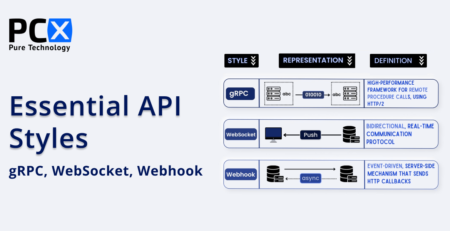Essential API Styles: SOAP, RestAPI, GraphQL
In today’s digital era, Application Programming Interfaces (APIs) play a crucial role in connecting different software systems and enabling seamless data exchange. APIs serve as a bridge, allowing applications to communicate with each other and access the functionalities and data they require. When it comes to API development, there are several styles to choose from, each with its own strengths and considerations. In this article, we will delve into the essential API styles: SOAP, RESTful APIs, and GraphQL. Understanding these styles will empower you to make informed decisions when designing and implementing APIs for your projects.
SOAP (Simple Object Access Protocol)
SOAP, or Simple Object Access Protocol, is an XML-based messaging protocol that provides a standardized way of structuring messages and performing remote procedure calls. SOAP is built on top of the XML format, making it highly interoperable across different platforms and programming languages. It follows a strict set of rules and utilizes the XML Schema Definition (XSD) to define the structure and data types of the messages. #Soap
Advantages of SOAP
Standardization: SOAP is a well-established standard with clear guidelines and specifications, ensuring consistent implementation across different systems.
Extensibility: SOAP supports the addition of custom headers, allowing for the inclusion of additional information within the SOAP envelope.
Built-in Error Handling: SOAP provides comprehensive error handling mechanisms, making it easier to identify and resolve issues during communication between systems.
WS-Security: SOAP offers a range of security features, such as message encryption, digital signatures, and authentication, ensuring secure data transmission.
Limitations of SOAP
Complexity: SOAP messages tend to be more complex due to the XML structure, which can lead to increased overhead and slower performance.
Over-Engineering: SOAP’s strict adherence to standards and specifications can sometimes result in over-engineering, making it less suitable for simpler scenarios.
Limited Support for Web APIs: SOAP is primarily designed for enterprise-level integrations and may not be the best fit for lightweight web API implementations.
RESTful APIs (Representational State Transfer)
RESTful APIs, based on the principles of Representational State Transfer (REST), have gained immense popularity in recent years. REST emphasizes a stateless, client-server communication model, where resources are uniquely identified by URIs (Uniform Resource Identifiers) and are operated upon using standard HTTP methods such as GET, POST, PUT, and DELETE. RESTful APIs leverage the existing infrastructure of the World Wide Web and are widely used in web development. #RestAPI
Advantages of RESTful APIs
Simplicity: RESTful APIs have a simpler architecture compared to SOAP, making them easier to understand, implement, and maintain.
Scalability: REST’s stateless nature enables horizontal scalability, allowing systems to handle a large number of concurrent requests efficiently.
Flexibility: RESTful APIs support multiple data formats, including JSON (JavaScript Object Notation), XML, and more, providing flexibility in data representation.
Caching: REST leverages HTTP caching mechanisms, enabling improved performance and reduced network latency through the caching of responses.
Widespread Adoption: RESTful APIs are widely adopted and supported, with numerous frameworks and libraries available for various programming languages.
Limitations of RESTful APIs
Lack of Standardization: While REST provides architectural principles, it does not enforce a strict standard for implementation, leading to inconsistency across different APIs.
Limited Functionality for Complex Scenarios: RESTful APIs may struggle to handle complex scenarios that require multiple round trips or involve advanced data manipulation.
Discoverability: Unlike SOAP, which provides a well-defined contract through WSDL (Web Services Description Language), REST APIs typically lack a standardized means of discoverability.
GraphQL
GraphQL, developed by Facebook, is a query language and runtime for APIs. It differs from SOAP and RESTful APIs by providing a more flexible and efficient approach to data retrieval. With GraphQL, clients can specify the exact data they need, reducing the problem of over-fetching or under-fetching data commonly encountered with RESTful APIs. Instead of relying on multiple endpoints, GraphQL utilizes a single endpoint for all data requests. #graphql
Advantages of GraphQL
Efficiency: GraphQL enables clients to request precisely the data they need, reducing the amount of unnecessary data transferred over the network.
Flexibility: With GraphQL, clients have control over the structure of the response, allowing them to aggregate and shape data from multiple sources.
Versioning: GraphQL eliminates the need for versioning endpoints, as clients can explicitly request the specific fields and data they require.
Real-Time Updates: GraphQL subscriptions enable real-time data updates, making it suitable for applications that require live data feeds.
Limitations of GraphQL
Learning Curve: GraphQL introduces a new query language and requires developers to learn its syntax and concepts.
Caching: Caching GraphQL responses can be more challenging due to the dynamic nature of the queries and the personalized nature of the data.
Backend Complexity: Implementing GraphQL requires additional backend infrastructure and resolver functions to handle the queries and fetch the requested data.
Conclusion
In conclusion, the choice of API style depends on the specific requirements of your project. SOAP, RESTful APIs, and GraphQL each have their own strengths and considerations. SOAP offers a standardized and secure approach, while RESTful APIs provide simplicity and widespread adoption. GraphQL excels in scenarios where flexibility and efficient data retrieval are critical. By understanding the characteristics of these API styles, you can make informed decisions and leverage the most appropriate approach for your application.
Remember, when developing APIs, it’s essential to consider factors such as performance, security, scalability, and developer experience. Each style has its trade-offs, and selecting the right one will depend on your project’s unique needs. Stay up to date with the latest developments in API technologies, as the landscape continues to evolve, and new styles may emerge in the future.
Call us for a professional consultation



Leave a Reply